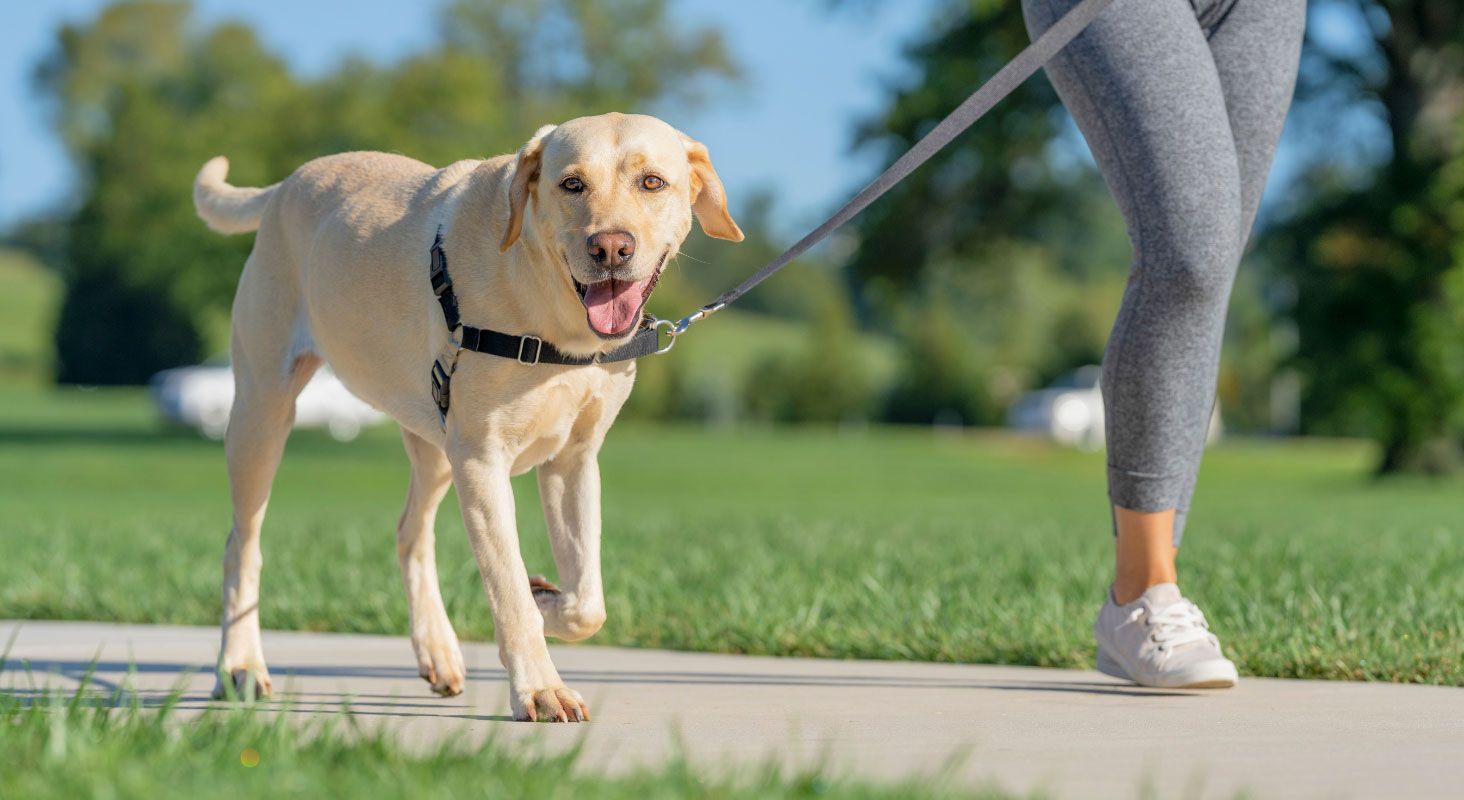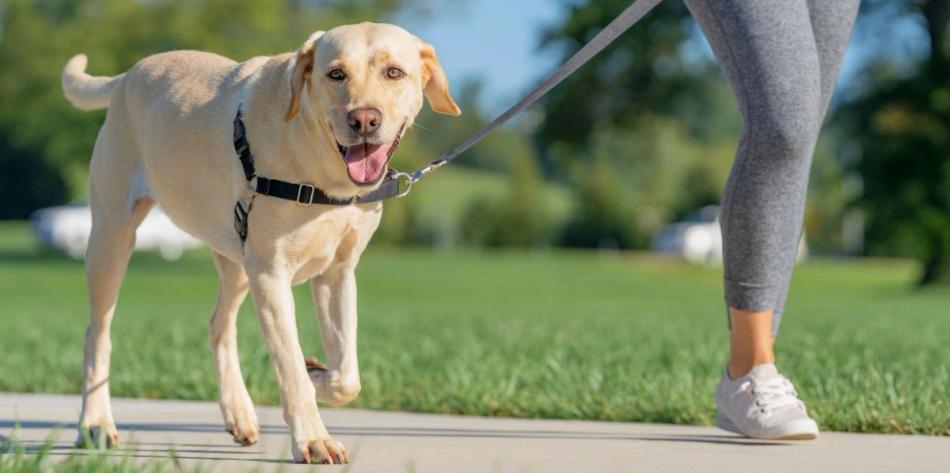
Who’s walking who? If you’ve ever asked that proverbial question about yourself and your own dog, you are not alone. Leash-pulling is not only a common behavior for dogs, it’s arguably a natural, instinctive one. Still, leashed walks are better for you and your pup if you’re not in a constant tug-of-war. So how do you stop leash pulling? The short answer is patient training with the right tools. But before you dive straight into leash training, it’s helpful to know why dogs pull and what tools are available to help.
Why do dogs pull on the leash?
Dogs may pull for a number of reasons, but no matter the motivation, leash pulling is an impulsive behavior that typically won’t go away without some kind of training. There are three main drives behind a dog’s leash-pulling behavior.
To go, go, go!
The first and perhaps most obvious motivation for leash-pulling for your dog is to get where he’s going. Some dogs start pulling right out of the gate. Any dog who is excited to go for a walk is likely to pull once you’re outside together. Think about how your dog travels when he is off leash. Dogs’ natural movements aren’t in a straight line or at a steady speed. A dog roaming free will alternate between trotting, stopping, sniffing, strolling, rolling, zooming… you get the idea! The desire to simply go at his own pace may motivate your dog to pull. This type of pulling is often most intense at the start of a walk and tends to diminish as your dog tires himself out. Walking more frequently can help reduce the explosive bursts of energy a dog might have when he only gets to go for a walk every now and then.
To get closer to what they want
The desire to reach a target is a powerful motivator for dogs. As natural predators, dogs sometimes seem to get “tunnel vision” as they zero-in on a squirrel or rabbit. This laser-focused attraction can extend to non-prey items, such as other dogs or people walking up the sidewalk. In fact, any tantalizing sight, sound or smell can drive a dog to pull. This type of pulling can be particularly problematic because other people and pets are not always ready to greet a strange dog charging at them, no matter how friendly his intent! Pulling to reach targets such as other dogs is best addressed with focused training that works up to teaching your dog not to pull in the presence of such distractions. However, if your dog pulls with aggressive intent, lunging violently at people or pets, it’s important that you contact your veterinarian or a professional behaviorist to help you understand how to remedy this behavior safely.
The opposition reflex
This is the little-known key to most dogs’ persistent leash-pulling behavior. The aforementioned reasons are triggers for a dog to start pulling, but the opposition reflex is the reason a dog keeps pulling. Simply put, the opposition reflex is an instinctive tendency for dogs to pull against pressure. So when a dog is wearing a traditional collar or harness and gets to the end of his leash, he’ll feel pressure pulling him backwards. At this point, his body will automatically start pulling forwards. In fact, it’s natural for a dog who starts pulling to keep pulling harder the more you pull back on the leash (it’s not just your imagination!) As the name implies, this behavior is reflexive, meaning your dog probably doesn’t make a conscious decision to do it – once he feels the tension on the leash, his instinct kicks in and he just pulls harder, even if it’s uncomfortable for him. Sled dogs provide a perfect illustration of the opposition reflex at work. Historically, these dogs have pulled heavy sleds for miles in driving snow because they’re wired to move forward when they feel the backwards pressure of the load they drag behind them. The opposition reflex can be a challenge to beat with traditional training alone. The good news is that training tools are available that are specifically designed by experts to help you and your dog overcome the opposition reflex together!
What is the best solution for a dog pulling on the leash?
There are two types of wearable products that work against all three of the main reasons dogs pull. Not only are these effective training tools, they also provide a safer, more comfortable walking experience for your dog. Unlike traditional harnesses and collars, these products don’t put pressure on your dog’s throat or neck when he tries to pull. This is important, as a dog’s instinct to pull can sometimes lead to injury when he “chokes” himself pulling against a traditional collar. All in all, these solutions will help make walks better for you and for your dog.
A no-pull harness
These harnesses are designed to discourage pulling by effectively “tricking” the opposition reflex. Most no-pull harnesses have a leash attachment on the front near the dog’s breastbone. However, all so-called “no-pull” harnesses are not created equally. Only the PetSafe® Easy Walk® No-Pull Harness has a patented front Martingale loop. The Martingale loop is a simple but clever design that causes the harness to tighten slightly when pressure is applied. Because the Easy Walk has a Martingale loop at the front where the leash attaches, the harness tightens at the front of the chest, causing your dog to feel pressure in front of him rather than from behind. Thus, there is no backwards pressure to pull against, and the opposition reflex is outsmarted!

A no-pull headcollar
A headcollar is an alternative to a no-pull harness. Both tools can be effective ways to stop leash pulling, but headcollars are often chosen for dogs who are especially strong or determined pullers. Despite its appearance, a headcollar is not a muzzle. Though it might look a bit like a muzzle at first glance, headcollars are designed for comfort and allow your dog complete freedom to bark, pant, drink and eat. A headcollar is worn a bit like a halter for a horse (also well-known for their pulling prowess) and works in the same basic way that a no-pull harness does, by overcoming the opposition reflex. The PetSafe® Gentle Leader® No-Pull Headcollar is well-known among veterinarians and trainers as a trusted solution to troublesome leash pulling. The Gentle Leader has a soft, padded neoprene loop that is worn around your dog’s snout. The leash attachment hangs beneath your dog’s chin. When your dog tries to pull, the Gentle Leader directs your dog’s head, and thus his attention, back towards you and the leash. The Gentle Leader can be a life-changing asset for people with large, energetic dogs who tend to pull powerfully on the leash. Many a small person walking a big dog can do so confidently thanks to the Gentle Leader’s simple, effective design.

How to walk a dog that pulls
The Easy Walk and the Gentle Leader are both the results of collaboration among veterinary behaviorists seeking a smarter way to overcome instinctive leash pulling. However, it’s important to recognize that these are training tools and there is no guaranteed “easy button” when it comes to persistent leash pulling. Some dogs may dramatically reduce their pulling behavior within a few days of use with one of these tools, but most dogs will benefit from a combination of proactive training choices alongside a wearable no-pull solution, as experts like the American Kennel Club recommend.
Choose the right time and setting for walks
An important factor in helping your dog overcome his pulling behavior is to choose the right place and time for leash training. Especially at the beginning, it is typically best to train in a quiet setting with minimal potential distractions. Avoid walking your dog in crowded areas or during busy times at first so he can focus on training. Training later in the day, after your dog has had a chance to work off some energy playing is also a good idea. A dog that is bursting with pent-up energy may need some cool-down time before he’s ready to learn. Once you’ve made some progress in a calm, distraction-free setting, you can begin introducing distractions like other dogs and people as you continue training.
Train your dog to walk on the leash
The keys to successfully training your dog to stop pulling (or for any training endeavor!) are consistency, patience and persistence.
Try a no-pull solution like Easy Walk or Gentle Leader
This is a great first step as it will help you overcome the stubborn opposition reflex. While you’re training, your dog should wear the solution every time you’re in a situation where he’s likely to pull on the leash.
Start simple
If possible at first, avoid the things that you know trigger your dog (such as other dogs) while walking until he’s made some basic progress with training.
Begin rewarding your dog any time he doesn’t pull
Reward the behavior you want – in this case, not pulling. Keep treats with you whenever you have your dog on-leash.
When he tries to pull, stop walking and wait for the leash to go slack
Don’t tug or yank on the leash, just stop walking and maintain a steady tension until he stops pulling. It’s important to reward him consistently as soon as the leash goes slack.
Praise and reward your pup any time the leash goes slack
Be mindful of any tension on the leash and keep the treats coming. Remember, you’re ultimately teaching your buddy to stay close to you, and that means no tension on the leash.
Start introducing distractions
Once he begins to understand that a slack leash is a good thing, you can begin to introduce him to the things that drive him to pull. Again, the process is the same. If your dog starts pulling, stop walking forward and reward him when he lets the leash go slack.
Remember to be consistent
Because your dog can feel whether there is tension on the leash, consistently rewarding him every time the leash go slack can be a very effective way to condition him to favor that sensation, and therefore to avoid putting tension on the leash by pulling.
The combination of a no-pull harness or headcollar and patient, consistent training can work for even the most energetic pullers. By outsmarting the opposition reflex and rewarding your dog when he doesn’t pull, you can approach the problem behavior from both sides and see real results. That means safer, more comfortable and more enjoyable walks for you and your best friend.


